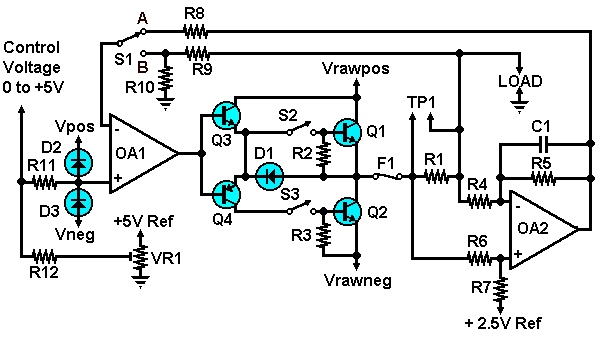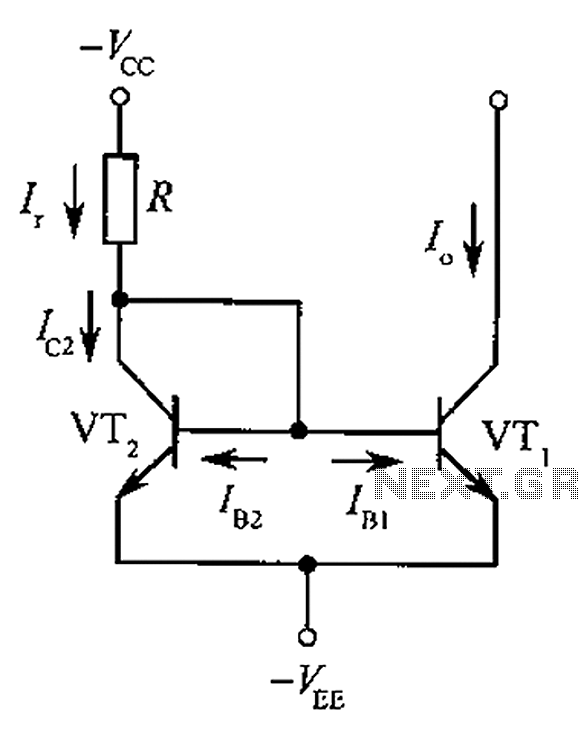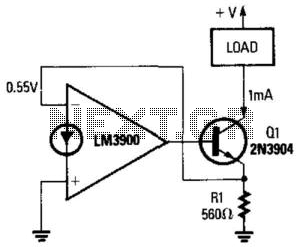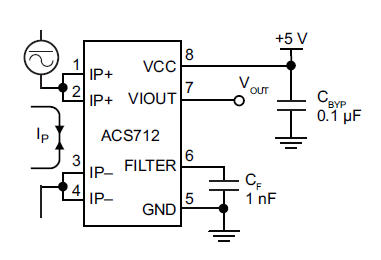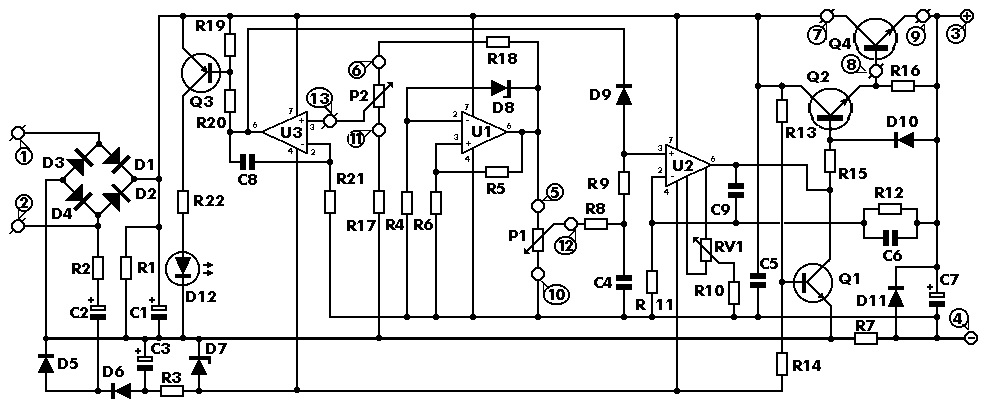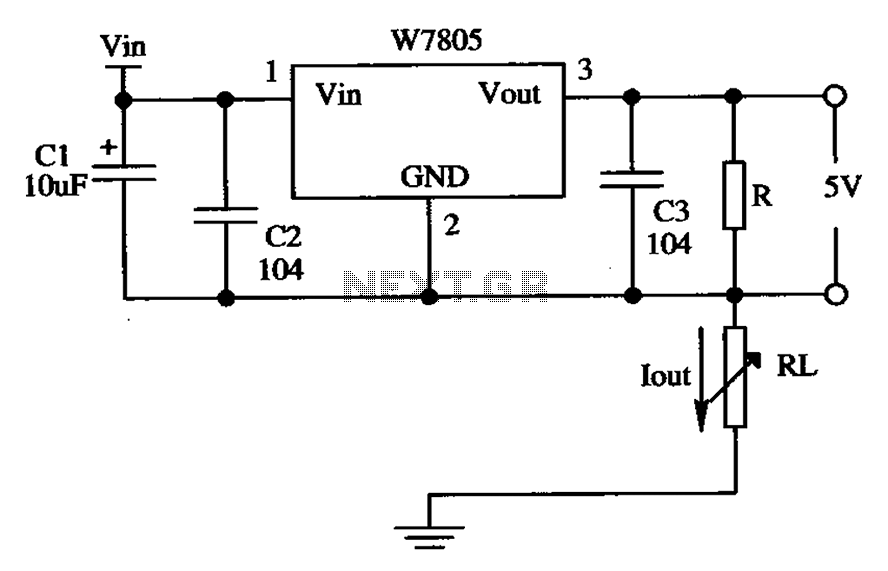
FOLDBACK CURRENT LIMITER
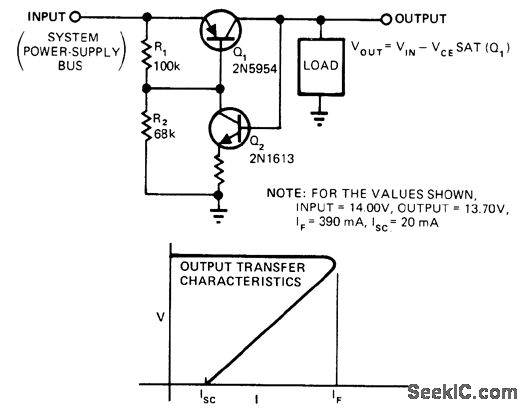
This circuit provides overload and short-circuit protection for a load while isolating malfunctioning circuits from other loads on a common supply bus. During normal operation, transistor Q1 is in saturation. When the load attempts to draw more current than the saturation limit, the base current of Q1 can no longer maintain saturation, resulting in a voltage drop across an unmarked resistor and a corresponding decrease in current through Q1. In the event of a short circuit, transistor Q2 turns off, causing the short-circuit current to fold back to a safe lower value. The value of the unmarked resistor must be chosen to ensure that Q1 remains in saturation at the specified load current.
The circuit operates by utilizing two transistors, Q1 and Q2, to manage the current flow and protect against overload conditions. Q1 is configured as a current-sensing device that monitors the load current. Under normal operating conditions, Q1 remains in saturation, allowing current to flow freely to the load. However, when the load current exceeds a predetermined threshold, the base current of Q1 decreases, leading to a reduction in collector current. This causes a voltage drop across the unmarked resistor, which can be calculated based on the desired saturation point of Q1.
When a short circuit occurs, the current through the load rises dramatically, triggering Q2 to turn off. This action effectively disconnects the load from the power supply, preventing damage to both the load and the power supply. The feedback mechanism provided by Q2 ensures that the short-circuit current is limited to a safe level, thus enhancing the reliability of the circuit.
To implement this circuit successfully, careful selection of the unmarked resistor value is crucial. It should be chosen based on the maximum load current that the circuit is designed to handle, ensuring that Q1 remains in saturation during normal operation. The design should also consider the power ratings of the components used to prevent overheating and ensure long-term reliability. Overall, this circuit design provides a robust solution for protecting electrical loads in various applications.Provides overload and short-circuit protection for load while isolating malfunctioning circuit from other loads on common supply bus. In normal operation, Q1 is saturated. When load attempts to draw more than this saturation value, base current of Q1 cannot maintain saturation so voltage across unmarked resistor drops and current through Q1 drops
correspondingly. When load is shorted, Q2 goes off and short-circuit current folds back to safe lower value. Choose value of unmarked resistor to ensure saturation of Q1 at load current. -S. T. Venkataramanan, Simple Circuit Isolates Defective Loads, EDN Magazine, Jan. 20, 1978, p 114. 🔗 External reference
The circuit operates by utilizing two transistors, Q1 and Q2, to manage the current flow and protect against overload conditions. Q1 is configured as a current-sensing device that monitors the load current. Under normal operating conditions, Q1 remains in saturation, allowing current to flow freely to the load. However, when the load current exceeds a predetermined threshold, the base current of Q1 decreases, leading to a reduction in collector current. This causes a voltage drop across the unmarked resistor, which can be calculated based on the desired saturation point of Q1.
When a short circuit occurs, the current through the load rises dramatically, triggering Q2 to turn off. This action effectively disconnects the load from the power supply, preventing damage to both the load and the power supply. The feedback mechanism provided by Q2 ensures that the short-circuit current is limited to a safe level, thus enhancing the reliability of the circuit.
To implement this circuit successfully, careful selection of the unmarked resistor value is crucial. It should be chosen based on the maximum load current that the circuit is designed to handle, ensuring that Q1 remains in saturation during normal operation. The design should also consider the power ratings of the components used to prevent overheating and ensure long-term reliability. Overall, this circuit design provides a robust solution for protecting electrical loads in various applications.Provides overload and short-circuit protection for load while isolating malfunctioning circuit from other loads on common supply bus. In normal operation, Q1 is saturated. When load attempts to draw more than this saturation value, base current of Q1 cannot maintain saturation so voltage across unmarked resistor drops and current through Q1 drops
correspondingly. When load is shorted, Q2 goes off and short-circuit current folds back to safe lower value. Choose value of unmarked resistor to ensure saturation of Q1 at load current. -S. T. Venkataramanan, Simple Circuit Isolates Defective Loads, EDN Magazine, Jan. 20, 1978, p 114. 🔗 External reference
